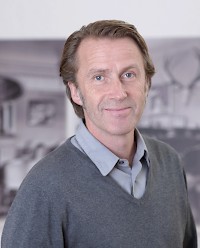Vita
Trond Lundemo is an Associate Professor at the Department of Cinema Studies at Stockholm University since 1996. In the same year, he received his PhD for his dissertation entitled “Bildets oppløsning; Filmens bevegelse i historisk og teoretisk perspektiv” (which translates as: “Resolution of Images; Film Movement from a historical and theoretical perspective”). He has been a visiting professor and visiting scholar at the Seijo University of Tokyo on five oc-casions between 2002 and 2011. In 2012, he was also a visiting professor at Kobe College in Japan. From 2005 to 2008, he worked on the topic of “Image Intersections”, funded by the Swedish Research Council. In 2011, he started another research project of his, “The Archive in Mo-tion”, funded by the Research Council of Norway. Since 2006, he is co-directing the Stockholm University Graduate School of Aesthetic Scienc-es. In 2010, he began his work as co-editor of the book series "Film Theory in Media History” at Amsterdam University Press, together with Swiss and German media scholars Vinzenz He-diger and Oliver Fahle. Professor Lundemo is a Steering Committee member of the European Network for Cinema and Media Studies (NECS). Furthermore, he participates in the research project ”Time, Memory and Representation” at Södertörns University College, Sweden, since 2011.
Dated from 2014
Fields of Research
History and theory of film; theory of the archive; technology studies; media and temporality; aesthetics; questions of intermediality.
IKKM Research Project
The main tenet of this project is that technological shifts inform the concept and the writing of history and how one understands the past. Following Siegfried Kracauer’s contention in his last, unfinished book, History; The Last Things before the Last (1969), that the modern concept of history was informed by the emergence of photographic media, I will analyse how historical formations have been subject to change through shifts in media technologies. If photography informs the modern concept of history, how have later technological shifts, as cinema and digital media, shaped historical articulations and consciousness? Departing from montage as a key concept for articulations of the past, the project aims to differenciate between various concepts of montage, as well as between montage practices. There are many different forms of montage in cinema as well as in other media, and it is the aim of this project to analyse how these modes of juxtaposition and connectivity produce different forms of articulations of the past. This entails rereading film montage theories as historiographical theories with a focus on their technological underpinnings. I also aim to expand these concepts of montage to other technical media and art forms to derive historiographical properties implicit or explicit within these practices. If one keeps with the thesis that technological shifts inform our sense of history, one must ask what are the effects of the end of photo-chemical inscription and the advent of digital transcription of visual events. If the modern concept of history was, in part at least, informed by photographic technology, what sense of the past is communicated by the digital technologies? One possible place to start this inquiry is in the automated pattern recognition techniques developed in recent software. With the current ubiquity of digital images, where almost every work process, transaction and consumption takes place through the image, the access to the past always proceeds through an analysis of images. With an all-pervasive process of digitization of analogue images – photo-chemical or videographic – the past as it is stored and constituted in images is readily accessible for software operations. This leads one to speculate if the shift from the modern historiography informed by the photographic technology is giving way to an 'archaeographic' approach to the past. The latter approach is not aimed at the production of linear historical narratives, but instead at articulations about the past produced by the technological dispositives themselves.
Publikations
Monographs
The Intelligence of a Machine. Stockholm: Cinemateket 2001. Bildets oppløsning; Filmens bevegelse i historisk og teoretisk perspektiv. Oslo: Sparta-cus Forlag 1996.
Articles
“Media Archeology and Montage”. In: Helena Holmberg (ed.): Lina Selander: Lenin’s Lamp Glows in the Peasant’s Hut. Stockholm: Oei editor (forthcoming). “‘The Archives of the Planet’ and Montage: the Movement of the Crowd and ‘the Rhythm of Life’. In: Kjetil Jacobsen (ed.): Albert Kahn's Archives de la Planète. Cos-mopolitanism, Media and Memory (forthcoming). “A Temporal Perspective: Jean Epstein’s Writings on Technics and Subjectivity”. In: Sarah Keller, Jason N. Paul (eds.): Jean Epstein. Critical Essays and New Translations. Amsterdam: Amsterdam University Press 2012, pp. 207-225. “Atomic Hindsight: Technology and Visibility as Factors in Historical Periodization”. In: Hans Ruin and Andrus Ers (eds.): Rethinking Time. Stockholm: Södertörn 2011, pp. 311-319. “Archival Shadows”. In: Eivind Røssaak (ed.): The Archive in Motion. New Concep-tions of the Archive in Contemporary Thought and New Media Practice. Oslo: Nota bene 2010, pp. 183-196. “Archive Theory as Film Theory”. In: Francesco Casetti, Jane Gaines, Valentina Re (eds.): At the Very Beginning – at the Very End; Film Theory in Perspective. Udine: Università degli studi/Forum 2010, pp. 33-38. “In the Kingdom of Shadows: Cinematic Movement and its Digital Ghost”. In: Pelle Snickars/Patrick Vonderau (eds.): The YouTube Reader. Stockholm: The National Li-brary of Sweden 2009, pp. S. 314-329. “Kong Haakon VII ankommer Christiania”. In: Tytti Soil (ed.): 24 Frames: The Cine-ma of Scandinavia. London: Wallflower 2005, pp. 15-24.
